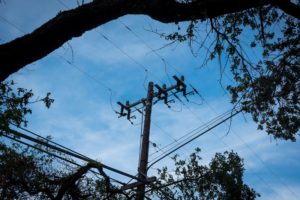The judge overseeing PG&E Corp.’s criminal probation is looking to tighten the leash on the utility by requiring it to take into account which power lines were cleared of trees before shutting them off during windstorms.
U.S. District Judge William Alsup said he’s trying to get the company to follow California law and its own wildfire mitigation plan to “protect the people of California from yet further death and destruction caused by the offender’s continuing failure to operate its power grid safely.”
In his role overseeing PG&E’s criminal probation, Alsup has expressed frustration and ire at the utility for its role in causing wildfires that have repeatedly claimed lives and destroyed large swaths of private and public property. The company emerged from bankruptcy on July 1, having agreed to pay $25.5 billion to settle damage claims from a series of deadly blazes blamed on its equipment.
The judge noted PG&E’s finding that 334 trees or limbs fell on distribution lines during four Public Safety Power Shutoffs — or PSPS — in October 2019. Of the fallen trees, PG&E estimated that 234 could have caused wildfires by “arcing,” in which electricity finds the closest conducting surface, such as dry grass, he said.
“It is most confounding that PG&E, in deciding which distribution lines to de-energize in a PSPS, ignored (and still ignores) the number one cause of wildfires ignited by PG&E: hazardous trees and limbs that should have, by law, been removed but which still loom as threats in windstorms,” Alsup wrote. “There can be no debate about the dangers of dead, dying, and untrimmed trees near live distribution lines.”

Alsup cited a December report from a monitor appointed to watch PG&E who found lapses in the company’s vegetation management program, including allowing trees to threaten power lines in violation of California law.
PG&E said it’s aware of the judge’s order and will respond with its own filing in court.
“We share the court’s focus on safety and recognize that we must take a leading role in preventing future catastrophic wildfires,” the company said in an emailed statement. “Our focus continues to be on reducing the risk present in our system and continuously improving our approaches to make California a better and safer place for our customers and communities.”
The judge ordered the company to respond by Jan. 20, and scheduled a hearing for Feb. 3.
Recounting what the judge called called PG&E’s “stunning chapter” in California history, Alsup said the company has ignited 20 or more wildfires in the state that killed at least 111 people, destroyed at least 22,627 structures, and burned half a million acres.
Alsup reitereated his past criticism that PG&E diverted funds from maintenance to bigger bonuses, dividends and political contributions.
“Inspections of lines and removal of hazardous limbs and trees got postponed,” and the “backlog of uncompleted work grew and grew.” After the 2017 Wine Country fires, PG&E, “though flush with cash, fled into bankruptcy to minimize its liability for those wildfires,” he wrote.
The case is U.S. v. PG&E, 14-cr-00175, U.S. District Court, Northern District of California (San Francisco).
Was this article valuable?
Here are more articles you may enjoy.

 NYC Sues Delivery App Over Lost Pay in New Mamdani Crackdown
NYC Sues Delivery App Over Lost Pay in New Mamdani Crackdown  Insurance Payments Now at $22.4B From LA Wildfires One Year Ago
Insurance Payments Now at $22.4B From LA Wildfires One Year Ago  Musk’s X Probed by UK Over Grok’s Thousands of Sexualized Images
Musk’s X Probed by UK Over Grok’s Thousands of Sexualized Images  California Bill Would Require Insurer Claims Handling Plans, And Double Penalties
California Bill Would Require Insurer Claims Handling Plans, And Double Penalties 